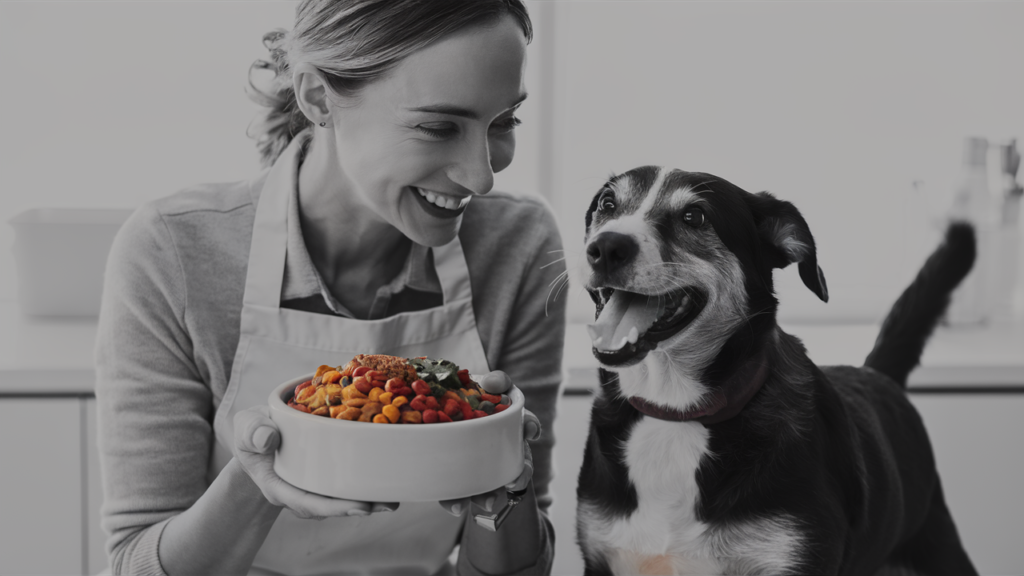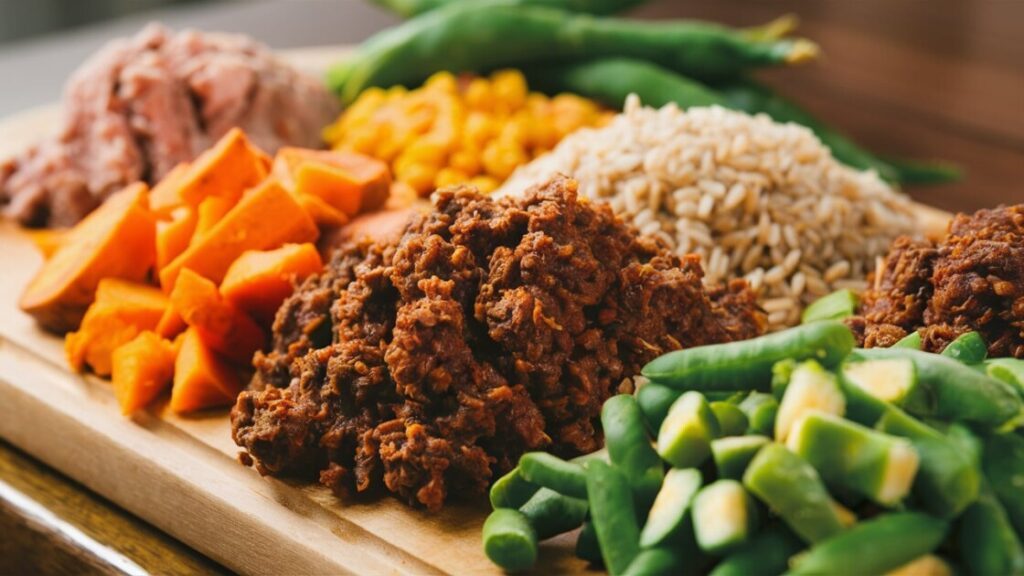Homemade Dog Food Recipes | Does your furry best friend suffer from itchy skin, constant licking, or watery eyes? These could be signs of a food allergy, leaving you wondering what to feed your beloved pup. Don’t fret, fellow pet lover! Homemade dog food recipes can offer a delicious and allergy-friendly solution.

This post dives into the world of homemade dog food for allergies, providing everything you need to know:
- Understanding Food Allergies in Dogs
- Benefits of Homemade Food for Allergies
- Essential Considerations for DIY Dog Food
- Delicious & Nutritious Allergy-Friendly Recipes
- Tips for Making & Storing Homemade Dog Food
By the end, you’ll be equipped to whip up scrumptious, allergy-soothing meals your pup will love while giving their sensitive tummy a break.
Decoding Dog Allergies: What You Need to Know
Food allergies are a common culprit behind itchy skin, digestive issues, and respiratory problems in dogs. When your pup ingests an ingredient they’re sensitive to, their immune system overreacts, causing these unpleasant symptoms.
Here’s a quick breakdown of food allergies in dogs:
- Common Allergens: The most common food allergens for dogs include beef, chicken, dairy, wheat, soy, and corn.
- Identifying the Culprit: If you suspect your dog has a food allergy, consult your veterinarian. They can recommend elimination diets to pinpoint the specific allergen.
Why Go Homemade? Benefits of Allergy-Friendly Dog Food
While commercially available food offers convenience, homemade meals for allergies can provide several benefits:

- Control Over Ingredients: Homemade food allows you to choose quality ingredients and eliminate the specific allergens your dog is sensitive to.
- Freshness Matters: You control the freshness and quality of ingredients, ensuring your pup gets the most nutritious food possible.
- Tailored Nutrition: You can customize recipes based on your dog’s age, breed, and activity level, ensuring they receive balanced nutrition.
- Improved Digestion: Homemade food can be easier for some dogs with sensitive stomachs to digest, reducing discomfort and promoting gut health.
Important Considerations Before Diving into DIY Dog Food
Before embarking on your homemade cooking adventure, consider these key points:
- Consult Your Vet: Always discuss your plans with your veterinarian. They can advise on nutrient requirements based on your dog’s specific needs and ensure your homemade recipe is complete and balanced.
- Research & Planning: Research dog nutrition to understand essential nutrients like protein, fats, carbohydrates, vitamins, and minerals. Ensure your recipes provide a balanced blend to keep your pup healthy.
- Time Commitment: Making homemade dog food requires time for planning, shopping, and preparing meals. Ensure you can commit to consistent meal preparation.
- Portion Control: Just like commercially prepared food, portion control is crucial. Overfeeding can lead to obesity, even with homemade meals.
Delicious Delights: Allergy-Friendly Recipes for Your Pup
Now for the fun part – the recipes! Here are a few delicious and allergy-friendly dog food options:
1. Turkey and Sweet Potato Delight:
This recipe is perfect for dogs with allergies to chicken or beef.
- Ingredients:
- 1 cup cooked and ground turkey
- 1 cup chopped sweet potato
- 1/2 cup cooked brown rice
- 1 tablespoon olive oil
- 1/2 cup chopped green beans (optional)
- 1/4 cup chopped parsley (optional)
- Instructions:
- Cook sweet potato until tender.
- Brown ground turkey in olive oil.
- Combine cooked turkey, sweet potato, and brown rice.
- Add chopped green beans and parsley for additional nutrients (optional).
2. Salmon and Quinoa Medley:
This grain-free recipe is ideal for dogs with sensitivities to wheat and other grains.
- Ingredients:
- 1 cup cooked and flaked salmon
- 1 cup cooked quinoa
- 1/2 cup chopped carrots
- 1/4 cup chopped broccoli
- 1 tablespoon coconut oil
- Instructions:
- Steam or boil carrots and broccoli until tender.
- Flake cooked salmon.
- Combine cooked salmon, quinoa, and vegetables.
- Drizzle with coconut oil for added flavor and healthy fats.
3. Lamb and Lentil Stew :
This hearty stew provides protein variety for dogs with allergies to common meats.
Ingredients:
- 1/2 cup cooked and ground lamb
- 1 cup cooked brown lentils
- 1 cup chopped zucchini
- 1/2 cup chopped peas
- 1 tablespoon vegetable broth
- Instructions:
- Cook brown lentils according to package instructions.
- Brown ground lamb in a pot.
- Add chopped zucchini and peas to the pot with the lamb and cook until tender.
- Combine cooked lentils with the cooked lamb and vegetables.
- Add vegetable broth for a bit of extra moisture (optional).
4. Venison and Sweet Pea Blend:
This recipe offers a novel protein source for dogs with allergies to common meats.
- Ingredients:
- 1/2 cup cooked and diced venison
- 1 cup cooked brown rice
- 1 cup chopped green beans
- 1/2 cup frozen peas
- 1 tablespoon fish oil
- Instructions:
- Cook brown rice according to package instructions.
- Dice and cook venison until tender.
- Steam or boil green beans until tender.
- Combine cooked venison, brown rice, green beans, and peas.
- Drizzle with fish oil for added omega-3 fatty acids.
5. Turkey and Oatmeal Bake:
This recipe is gentle on sensitive stomachs and provides a good source of fiber.
- Ingredients:
- 1 cup cooked and shredded turkey
- 1 cup cooked rolled oats
- 1 cup chopped apples (peeled and cored)
- 1/2 cup chopped pumpkin (optional)
- 1 tablespoon plain yogurt
- Instructions:
- Cook rolled oats according to package instructions.
- Shred cooked turkey.
- Chop and steam apples until softened.
- Combine cooked turkey, oats, apples, and pumpkin (optional).
- Mix in plain yogurt for added probiotics (optional).
Remember: These are just a few examples. Feel free to get creative and explore other allergy-friendly ingredients like duck, rabbit, or fish. Always consult reliable sources for dog nutrition guidance when formulating your own recipes.
Top Tips for Making and Storing Homemade Dog Food
Here are some handy tips to make your homemade dog food journey a success:

- Cook in Batches: Prepare and cook large batches of food to save time throughout the week.
- Portion Control & Storage: Portion out individual meals for your pup and store them in airtight containers in the refrigerator for up to 3 days.
- Freeze for Long-Term Storage: Freeze leftover cooked meals in individual portions for future use.
- Thaw Thoroughly Before Serving: Always thaw frozen meals completely before feeding to your dog.
- Monitor Your Pup: Pay close attention to your dog’s health and energy levels after switching to homemade food. If you notice any negative changes, consult your veterinarian.
Remember, consistency is key! Sticking with a well-balanced homemade food recipe can significantly improve your dog’s overall health and well-being, especially if they suffer from allergies.
Conclusion: A Recipe for Love and Happy Tails
You’re showering them with love and care by taking control of your dog’s diet and preparing allergy-friendly homemade meals. These delicious recipes offer a great starting point, but don’t be afraid to experiment and personalize them to your pup’s preferences. With proper planning and guidance from your veterinarian, homemade dog food can be a rewarding and healthy solution for your furry friend with allergies.
Now go forth, unleash your inner chef, and whip up some delicious, allergy-soothing meals for your beloved pup! Their happy tail wags and improved health will be your ultimate reward.
Important Resources:
- American Kennel Club (AKC): Food Allergies in Dogs https://www.akc.org/expert-advice/vets-corner/dog-allergies/
- VCA Animal Hospitals: Food Allergies in Dogs https://vcahospitals.com/know-your-pet/food-allergies-in-dogs
- World Small Animal Veterinary Association (WSAVA): WSAVA Global Guidelines for the Diagnosis and Management of Food Hypersensitivity in Dogs and Cats https://wsava.org/
FAQ: Homemade Dog Food Recipes for Allergies
Here are some frequently asked questions about homemade dog food recipes for allergies:
1. What are the most common allergens in dog food?
The most common allergens in dog food include beef, chicken, dairy, wheat, soy, and corn.
2. How can I tell if my dog has a food allergy?
Common signs of food allergies in dogs include itchy skin, excessive licking, watery eyes, vomiting, and diarrhea. Consulting your veterinarian is crucial for the proper diagnosis and identification of the specific allergen.
3. Is homemade dog food always better for allergies?
Not necessarily. High-quality commercially available food formulated for allergies can also be a good option. However, homemade food allows you to control the ingredients and eliminate the specific allergen your dog is sensitive to.
4. Do I need a special diet plan for my dog with allergies?
Yes. Discuss your plans with your veterinarian to create a well-balanced homemade recipe that meets your dog’s specific nutritional needs and addresses their allergen sensitivities.
5. How long will it take to see results after switching to homemade food?
It can take several weeks to see a noticeable improvement in your dog’s symptoms after switching to an allergy-friendly diet. Be patient and consistent with their new food.
6. Can I add supplements to homemade dog food?
You may consider adding supplements based on your veterinarian’s recommendation. However, a well-formulated homemade recipe should already provide the most essential nutrients.
7. How can I store homemade dog food?
Store portioned meals in airtight containers in the refrigerator for up to 3 days. Freeze leftover cooked meals in individual portions for long-term storage.
8. What should I do if my dog doesn’t like their homemade food?
There can be a few reasons for this. First, ensure the recipe is palatable and appealing. You can try adding a small amount of low-sodium broth or cooked, mashed vegetables for extra flavor. Alternatively, consult your veterinarian for guidance on adjusting the recipe or exploring commercially available allergy-friendly options.
9. Is making homemade dog food time-consuming?
It can be. Planning, shopping, and preparing meals require some time commitment. Consider preparing and cooking large batches to save time throughout the week.
10. Is homemade dog food more expensive than commercially prepared food?
The cost can vary depending on the ingredients you choose. However, homemade food can be more cost-effective in the long run, especially if you use high-quality ingredients.